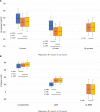Left Atrial Function Predicts Atrial Arrhythmia Recurrence Following Ablation of Long-Standing Persistent Atrial Fibrillation
- PMID: 37288553
- PMCID: PMC10281195
- DOI: 10.1161/CIRCIMAGING.123.015352
Left Atrial Function Predicts Atrial Arrhythmia Recurrence Following Ablation of Long-Standing Persistent Atrial Fibrillation
Abstract
Background: Left atrial (LA) function following catheter or surgical ablation of de-novo long-standing persistent atrial fibrillation (AF) and its impact on AF recurrence was studied in patients participating in the CASA-AF trial (Catheter Ablation vs. Thoracoscopic Surgical Ablation in Long Standing Persistent Atrial Fibrillation).
Methods: All patients underwent echocardiography preablation, 3 and 12 months post-ablation. LA structure and function were assessed by 2-dimensional volume and speckle tracking strain measurements of LA reservoir, conduit, and contractile strain. Left ventricular diastolic function was measured using transmitral Doppler filling velocities and myocardial tissue Doppler velocities to derive the e', E/e', and E/A ratios. Continuous rhythm monitoring was achieved using an implantable loop recorder.
Results: Eighty-three patients had echocardiographic data suitable for analysis. Their mean age was 63.6±9.7 years, 73.5% were male, had AF for 22.8±11.6 months, and had a mean LA maximum volume of 48.8±13.8 mL/m2. Thirty patients maintained sinus rhythm, and 53 developed AF recurrence. Ablation led to similar reductions in LA volumes at follow-up in both rhythm groups. However, higher LA emptying fraction (36.3±10.6% versus 27.9±9.9%; P<0.001), reservoir strain (22.6±8.5% versus 16.7±5.7%; P=0.001), and contractile strain (9.2±3.4% versus 5.6±2.5%; P<0.001) were noted in the sinus rhythm compared with AF recurrence group following ablation at 3 months. Diastolic function was better in the sinus rhythm compared with the AF recurrence group with an E/A ratio of 1.5±0.5 versus 2.2±1.2 (P<0.001) and left ventricular E/e' ratio of 8.0±2.1 versus 10.3±4.1 (P<0.001), respectively. LA contractile strain at 3 months was the only independent predictor of AF recurrence.
Conclusions: Following ablation for long-standing persistent AF, improvement in LA function was greater in those who maintained sinus rhythm. LA contractile strain at 3 months was the most important determinant of AF recurrence following ablation.
Registration: URL: https://www.
Clinicaltrials: gov; Unique identifier: NCT02755688.
Keywords: ablation; atrial fibrillation; left atrial function; left atrial strain; sinus rhythm.
Conflict of interest statement
Figures






References
-
- Rahman F, Kwan GF, Benjamin EJ. Global epidemiology of atrial fibrillation. Nat Rev Cardiol. 2014;11:639–654. doi: 10.1038/nrcardio.2014.118 - PubMed
-
- Njoku A, Kannabhiran M, Arora R, Reddy P, Gopinathannair R, Lakkireddy D, Dominic P. Left atrial volume predicts atrial fibrillation recurrence after radiofrequency ablation: a meta-analysis. Europace. 2018;20:33–42. doi: 10.1093/europace/eux013 - PubMed
-
- Donal E, Ollivier R, Veillard D, Hamonic S, Pavin D, Daubert JC, Mabo P. Left atrial function assessed by trans-thoracic echocardiography in patients treated by ablation for a lone paroxysmal atrial fibrillation. Eur J Echocardiogr. 2010;11:845–852. doi: 10.1093/ejechocard/jeq074 - PubMed
-
- Ma XX, Zhang YL, Hu B, Zhu MR, Jiang WJ, Wang M, Zheng DY, Xue XP. The usefulness of global left atrial strain for predicting atrial fibrillation recurrence after catheter ablation in patients with persistent and paroxysmal atrial fibrillation. Arch Cardiovasc Dis. 2017;110:447–455. doi: 10.1016/j.acvd.2016.11.005 - PubMed
-
- Moreno-Ruiz LA, Madrid-Miller A, Martinez-Flores JE, Gonzalez-Hermosillo JA, Arenas-Fonseca J, Zamorano-Velazquez N, Mendoza-Perez B. Left atrial longitudinal strain by speckle tracking as independent predictor of recurrence after electrical cardioversion in persistent and long standing persistent non-valvular atrial fibrillation. Int J Cardiovasc Imaging. 2019;35:1587–1596. doi: 10.1007/s10554-019-01597-7 - PMC - PubMed
Publication types
MeSH terms
Associated data
LinkOut - more resources
Full Text Sources
Medical

